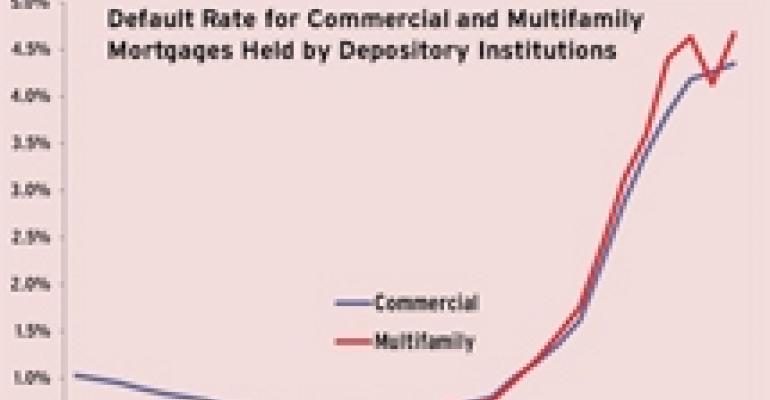Commercial property mortgage defaults rose in the third quarter, continuing an upward climb that began in 2006, according to analysis by New York City-based real estate research firm Real Capital Analytics.
Real Capital Analytics' findings are based on analysis of FDIC and bank data of commercial, multifamily and construction loans. Default rates rose by 9 basis points on commercial properties to 4.36 percent and by 54 basis points to 4.67 percent on multifamily properties in comparison with the second quarter. The default rate on construction loans stood at 16.63 percent--a 24 percent basis point decline compared with the second quarter. The rate counts mortgages at least 90 days delinquent and in non-accrual status.

The default rate on commercial properties has risen from a low of 0.58 percent in both the first and second quarters of 2006. The default rate is up from 3.41 percent a year ago and is approaching the record 4.55 percent default rate in 1992, according to Real Capital. Overall, $604.1 million of loans on commercial properties went into default in the three months ended Sept. 30.
In the third quarter, total commercial real estate mortgage balances fell by $8.8 billion. Year-to-date, balances have fallen by $18.5 billion. Multifamily balances increased slightly from the second to third quarter but also remain below their peak levels from last year.
According to Real Capital's analysis, default rates are highest at the largest institutions (those with $10 billion or more in assets), "where the concentrations in commercial real estate are lowest and the capacity to absorb related losses benefits from diversification." Default rates are generally lower at institutions with less than $1 billion in assets even though concentrations in commercial real estate, multifamily and construction lending are generally higher at these banks. For example, at banks with between $100 million and $1 billion in assets, the commercial mortgage default rate is 3.29 percent, 107 basis points lower than the national average, according to Real Capital.

According to Real Capital's commentary, "The weight of unresolved distress is manifest in greater regulatory and supervisory oversight when making new loans as well as adjustments in lending standards and many banks’ willingness to extend new credit in the sector. Demand for loans has also moderated. As a result of these shifts, banks have been drawing down their exposure to commercial real estate, making new loans at a slower pace than maturities, amortization, and distress has removed exposure from their balance sheets."
Going forward, the climate for lending is improving in some areas with large institutions, including life insurance companies, increasing their lending activity in the sector. However, "outside of the major metros – including New York, Washington DC, and San Francisco amongst a select few others – transaction activity and credit remain constrained," according to Real Capital.

